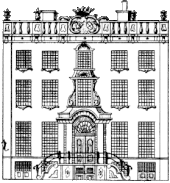Lieve Geelvinck


Lieve Geelvinck (born May 28, 1676 in Amsterdam ; † August 22, 1743 ibid) was Lord of the High and Free Glory of Mijnden , Lord of Castricum , the two Loosdrechte , Stabroek and Bakkum owner of the ruins of the former Kronenburg Castle, and Amsterdam regent during the first half of the 18th century.
Origin and family
The son of Joan Geelvinck, Lord of Castricum (1644–1707) and Anna van Loon came from the important aristocratic Geelvinck family , which had been in charge of their hometown for a long time. His grandfather was Cornelis Geelvinck , one of his uncles was Albert Geelvinck , who was one of the directors of the Suriname Society . Due to a clever marriage policy, the Geelvinck family played an important role in North Holland politics for a long time.
Geelvinck was first married to Agatha Theodora van Bambeek (1674-1713), through whom he came into the kinship of the Corver and Hooft families, who were very powerful in the city government until 1748 . His first marriage had four children, including the well-known politician Nicolaes Geelvinck . He married his second wife, Anna de Haze , in 1730. By marrying Anna de Haze, who was the niece of Jeronimo de Haze de Georgio , he inherited the noble titles of Stabroek, Mijnden and the two Loosdrechte.
Political career
- Sub-article: Regent of Amsterdam
Lieve Geelvinck became Schepen in 1704 and came to Amsterdam's Vroedschap in 1708 as his father's successor . Between 1709 and 1711 Councilor of the Netherlands , and between 1712 and 1714 he supported the council pensioner Simon van Slingelandt . In 1716 he was appointed one of the seventeen directors of the Dutch East India Company , which he held until his death in 1743. In 1720 Geelvinck was named for the first time as the ruling mayor of his hometown.
The republican-minded Geelvinck was, like so many other Dutch rulers of the 18th century, actively involved in the official negotiation. For example, he brought his son-in-law Dirck Trip (1691–1748), Mr. von Groet , into the city government, Trip was appointed mayor in 1735, and two further appointments followed in 1742 and 1748. In 1734 Geelvinck prepared the “cool” reception for Prince Wilhelm IV of Orange-Nassau and his wife Anna of Hanover in Amsterdam.
Lieve Geelvinck was buried in a family grave in the Oude Kerk .
See also
literature
- Elias, JE (1903–1905, reprint from 1963) De vroedschap van Amsterdam 1578–1795 (second part)
- Porta, A. (1975) Joan and Gerrit Corver. De politieke macht van Amsterdam (1702–1748)
Web links
Individual evidence
| predecessor | Office | successor |
|---|---|---|
| Anna de Haze |
Lord of the High and Free Glory of Mijnden and Lord of the two Loosdrechte 1730–1743 |
| predecessor | Office | successor |
|---|---|---|
| Jan Trip van Berckenrode , Jan (II.) Van de Poll and Egidius van den Bempden |
Regent and Mayor of Amsterdam 1720–1743, together with Jan Six van Hillegom (1719–1748) |
Willem Munter and Gerrit Corver |
| personal data | |
|---|---|
| SURNAME | Geelvinck, Lieve |
| BRIEF DESCRIPTION | Mayor of Amsterdam |
| DATE OF BIRTH | May 28, 1676 |
| PLACE OF BIRTH | Amsterdam |
| DATE OF DEATH | August 22, 1743 |
| Place of death | Amsterdam |
